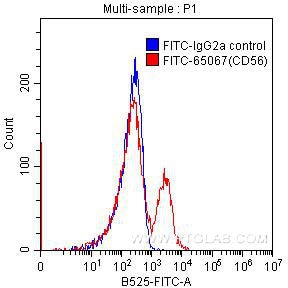NCAM1/CD56 Monoklonaler Antikörper
NCAM1/CD56 Monoklonal Antikörper für FC
Wirt / Isotyp
Maus / IgG2a, kappa
Getestete Reaktivität
human
Anwendung
FC
Konjugation
FITC Fluorescent Dye
CloneNo.
MEM-188
Kat-Nr. : FITC-65067
Synonyme
Geprüfte Anwendungen
| Erfolgreiche Detektion in FC | humane Lymphozyten aus peripherem Blut |
Empfohlene Verdünnung
| Anwendung | Verdünnung |
|---|---|
| This reagent has been pre-titrated and tested for flow cytometric analysis. The suggested use of this reagent is N/A per 10^6 cells in a 100 µl suspension or N/A per 100 µl of whole blood. | |
| Sample-dependent, check data in validation data gallery | |
Produktinformation
FITC-65067 bindet in FC NCAM1/CD56 und zeigt Reaktivität mit human
| Getestete Reaktivität | human |
| Wirt / Isotyp | Maus / IgG2a, kappa |
| Klonalität | Monoklonal |
| Typ | Antikörper |
| Immunogen | Akute myeloische Leukämie-Zelllinie KG-1 |
| Vollständiger Name | neural cell adhesion molecule 1 |
| GenBank-Zugangsnummer | BC014205 |
| Gene symbol | NCAM1 |
| Gene ID (NCBI) | 4684 |
| Konjugation | FITC Fluorescent Dye |
| Excitation/Emission maxima wavelengths | 498 nm / 526 nm |
| Form | Liquid |
| Reinigungsmethode | Affinitätsreinigung |
| Lagerungspuffer | PBS with 0.09% sodium azide |
| Lagerungsbedingungen | Store at 2-8°C. Avoid exposure to light. Stable for one year after shipment. |
Hintergrundinformationen
Neural cell adhesion molecule 1 (NCAM1, also known as CD56) is a cell adhesion glycoprotein of the immunoglobulin (Ig) superfamily. It is a multifunction protein involved in synaptic plasticity, neurodevelopment, and neurogenesis. NCAM1 is expressed on human neurones, glial cells, skeletal muscle cells, NK cells and a subset of T cells, and the expression is observed in a wide variety human tumors, including myeloma, myeloid leukemia, neuroendocrine tumors, Wilms' tumor, neuroblastoma, and NK/T cell lymphomas.
Protokolle
| PRODUKTSPEZIFISCHE PROTOKOLLE | |
|---|---|
| FC protocol for FITC NCAM1/CD56 antibody FITC-65067 | Download protocol |
| STANDARD-PROTOKOLLE | |
|---|---|
| Klicken Sie hier, um unsere Standardprotokolle anzuzeigen |


